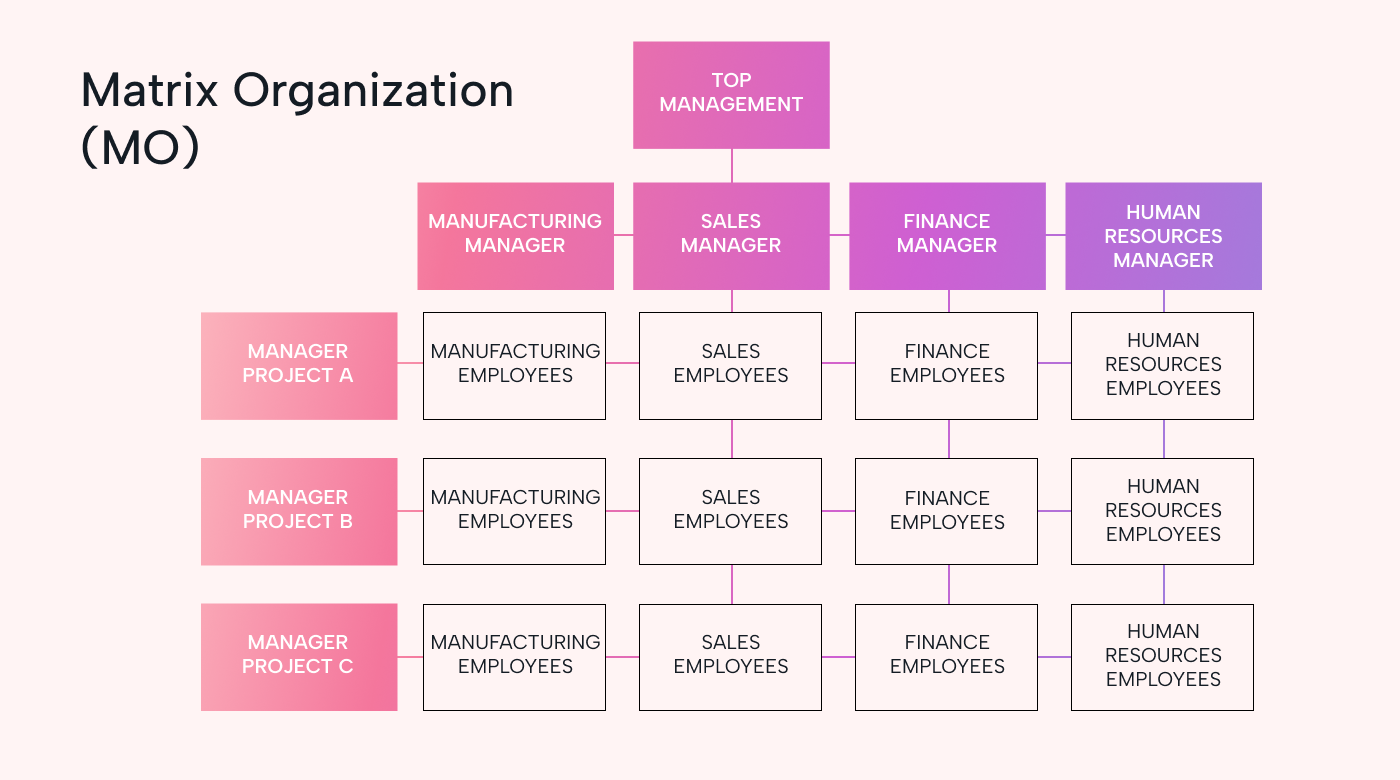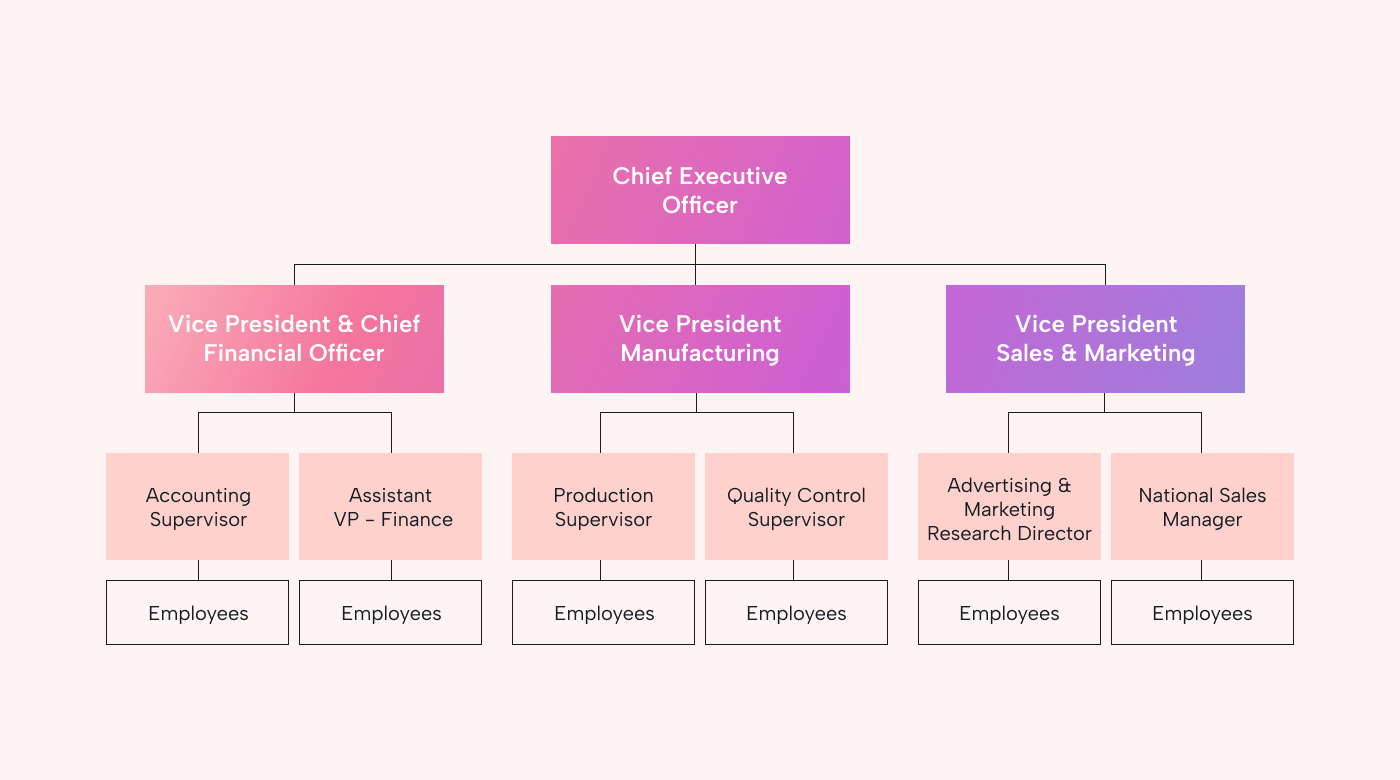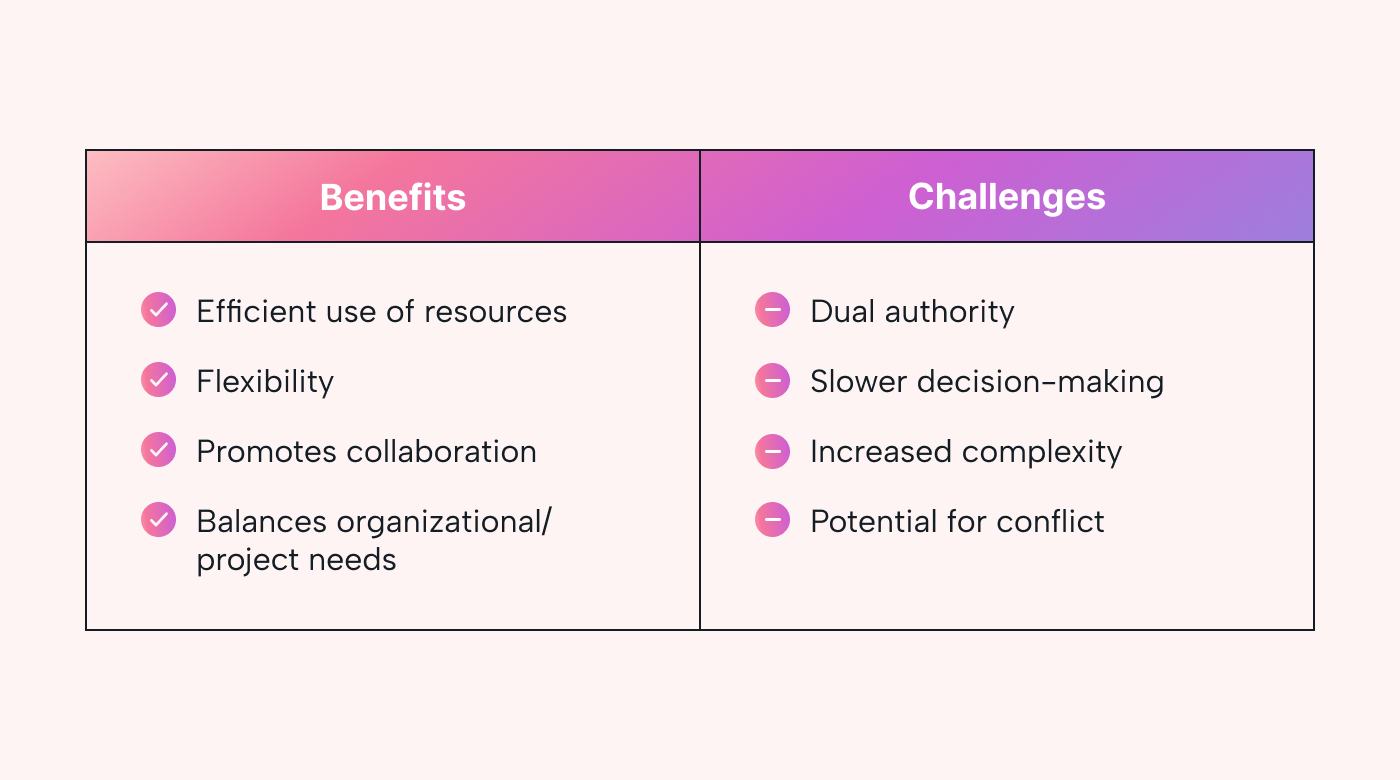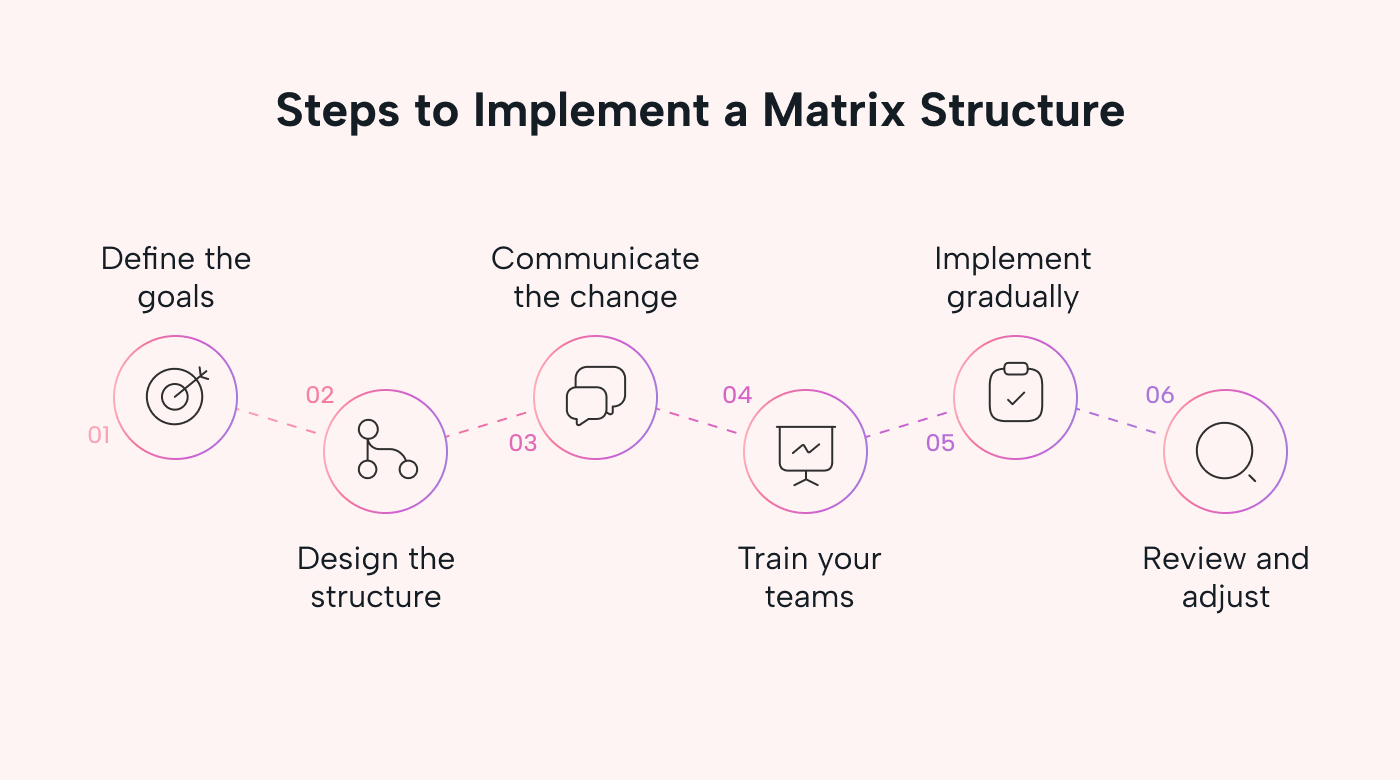A matrixed organization is a business in which employees have more than one boss.
In this article, we’ll expand on what that means, cover the pros and cons of this system, offer advice as to when this structure would be right for you, and go through some powerful steps on how to implement it.
Ready? Let’s dive in.
Understanding matrixed organizations
Today’s business environment is dynamic and complex. That means organizational structure is more important than ever in shaping company success.
Matrixed organizations have a compound organizational structure that differs from a traditional top-down hierarchy.
What is a matrixed organization?
At its core, a matrixed organization is a system in which employees report to multiple managers. Employee roles are often flexible and cover more than one discipline.
Think of the matrix organizational model as a web of employees managed by more than one authority.
 |
To give you an example: a software engineer might report to a product manager (for product-related tasks) and a department head (for more functional duties).
Consider the tech giant Philips. Employees report to both a geographical manager and a product manager. This system allows the company to have a strong presence in various geographical locations while maintaining a robust focus on product development.
How does a matrix structure compare to a traditional hierarchical structure?
A traditional hierarchical structure follows a top-down approach, where communication and orders flow from top management down to the employees. In this model, employees report to just one manager.
 |
This vertical structure is a familiar model for many.
Think of a CEO and other top executives sitting at the top of a pyramid. Below them are department heads and mid-level managers. At the bottom sit the employees.
The traditional organizational structure has been a successful one for some time. The reasons for this success include the following:
- It ensures that authority and the chain of command are clear.
- Accountability is clear.
- There are straightforward channels for communication.
However, the traditional structure lacks flexibility. As such, it’s been called into question in today’s business environment.
Why did the matrix structure evolve?
The matrix structure evolved to overcome the limitations of traditional structures. It was an organizational response to meet the demands of a rapidly evolving business world.
For example, when Mars was restructuring its pet care division, it enlisted junior managers to help shape its organization.
As Mars CEO Poul Weihrauch said, “The organization chart of the 1850s that had hierarchy at its core is no longer relevant. We need to build for communities, not for hierarchies.”
Those conventional hierarchies led to “silos” — areas where departments worked in isolation, which often hindered collaboration, innovation, and responses to market changes.
The matrix approach emerged as a solution. Promoting cross-functional collaboration enables organizations to respond to problems more rapidly and innovate more effectively.
Even before the pandemic, 72% of U.S. employees were already working in matrixed teams. And as more teams go hybrid, that number is likely to grow.
Pros and cons of matrixed organizations
Like anything, a matrixed organization has pros and cons. In this section, we’ll lay out the benefits and challenges it presents.
 |
Benefits of the matrix structure
First up are the benefits.
Offers efficient use of resources
In a matrix structure, your skilled employees can contribute to multiple projects.
For example, an IT specialist in a tech firm might work on software development and advise on a cybersecurity initiative at the same time.
This approach leverages an employee’s expertise and increases productivity. But it also saves on costs because you have one person covering two roles they’re good at.
Provides adaptability and flexibility
In a matrix structure, resources can be reallocated quickly in response to market changes or project demands.
For example, if a fashion retailer spots a rising trend for sustainable clothing, it could quickly pivot its design, marketing, and sourcing teams to focus on this new demand.
Flexibility keeps companies at the forefront of trends.
Promotes collaboration
Cross-functional collaboration is another benefit of this work structure.
For example, consider a car manufacturing company in which a marketing professional and an engineer are collaborating on a product launch. Their diverse perspectives could lead to innovative ideas that might not surface otherwise.
Balances organizational and project needs
With multiple layers of management, it’s easier to maintain a balance between strategic goals and specific project needs.
For example, a pharmaceutical company can work on its long-term goal of developing new medications while also focusing on the immediate production of a vaccine to combat an epidemic.
Challenges of the matrix structure
Now that we’ve covered the benefits of the matrix structure, let’s discuss some of the challenges involved.
Dual authority
While having multiple bosses can be beneficial, it can also present a challenge.
 |
Multiple leaders can lead to confusion among employees. Two managers may provide conflicting instructions or disagree over priorities.
For instance, a product manager might push for speedy development, while a quality control manager might insist on thorough testing.
Multiple demands can leave employees torn between different management goals, creating tension and inefficiency.
Slower decision making
Unlike a traditional hierarchy, where a single manager makes decisions, matrix management requires consensus from multiple leaders or individuals.
While this inclusive approach can lead to better decisions, it can also be time-consuming to reach those decisions.
For instance, if you were launching a new product, you might need consensus from both the product team and the marketing team. But it might take time to reconcile the perspectives of those two teams, which can delay the project timeline.
Increased complexity
While collaboration among teams and departments is beneficial, the need for constant alignment can complicate work.
Clear and efficient communication from leaders is necessary to keep everyone in the loop without tasks becoming chaotic.
Potential for conflict
Overlapping authority can increase the risk of power struggles or interpersonal conflicts.
Suppose a sales manager wants to offer a hefty discount to close a deal, but the finance manager is opposed due to budget concerns. This issue could lead to a power struggle.
The roles and decision-making authorities in the organization should be clearly defined to help prevent this problem.
How do you know if being a matrixed organization is ideal?
Here are some circumstances that warrant matrix management — and others that don’t.
When it makes sense to use a matrix structure
It’s best to use the matrix approach in the following circumstances:
With large, multifaceted companies
If your company is large with many moving parts or diverse product lines or services, a matrix structure is probably a good option.
For example, a multinational corporation with a wide range of products might benefit from the matrix setup to maximize skills and knowledge across departments.
With project-centered industries
Industries that revolve around projects include construction, software development, and consulting. A matrix structure can allow project teams in these types of companies to focus on their projects while remaining in line with the broader organizational objectives.
With companies that are geographically dispersed
If your company has operations in different locations or countries, a matrix structure can help ensure that each region’s unique needs are addressed — without neglecting the overall corporate strategy.
For instance, a global retail chain might use matrix management to adapt to local market trends while staying true to its global brand identity.
When it doesn’t make sense to use a matrix structure
It’s wise to reconsider becoming a matrixed organization in the following circumstances:
If the company’s so small that a matrix management structure is unnecessary
The informal communication and direct reporting lines in a very small company often eliminate the need for a matrix setup.
If the environment is stable and predictable
In industries where change is slow and operations are predictable, the complexity of a matrixed organization may be unnecessary.
 |
If your structure is strongly hierarchical and resistant to change
The matrix approach requires a shift from a vertical approach to a more collaborative, horizontal one. If you expect your organization will strongly resist this shift, it may not be worth implementing a matrix structure.
How to successfully create a highly matrixed organization
Adopting a matrix structure presents unique opportunities and challenges. Here, we’ll discuss the skills you need to be successful and the exact steps for this structure’s implementation.
Necessary skills to make a matrixed organization work
The following skills are essential for implementing a matrix structure in a company:
Strong communication
With multiple reporting lines and cross-functional collaboration, clear and effective communication is critical. Everyone should understand their roles, responsibilities, and to whom they report.
Highly matrixed teams are less likely to know what’s expected of them — and that’s not good.
On the contrary, employees whose managers clarify their work priorities are almost four times as likely to be engaged and 53% less likely to feel burnt out at work.
Conflict resolution
Given the potential for conflicting instructions and priorities, the ability to negotiate and resolve conflict is key in a matrix structure.
An organizational culture should encourage win-win outcomes and perspective-sharing when it comes to conflict.
Time management
Balancing tasks from different projects or departments requires excellent time management skills to avoid sacrificing quality.
Collaboration and teamwork
With the emphasis on cross-functional collaboration, the ability to work well in a team is a must in a matrixed organization. With fewer top-down chains of command, everyone is responsible for success.
A step-by-step guide to the matrix structure’s implementation
Follow the steps below to successfully implement a matrix management structure at your organization.
 |
Step 1: Define the goals
First, understand why you want to make the shift to a matrix team.
Ask yourself what challenges you want to overcome and what goals you’d like to reach.
Clear objectives will guide the process and help you measure success. Make sure it’s the right fit and that you have clear goals before going further.
Step 2: Design the structure
Design the matrix to reflect your objectives.
Who are the functional managers, and who are the product or project managers? How will these individuals interact?
Clearly define these dual lines of authority to avoid conflict.
Step 3: Communicate the change
Next, clearly communicate the changes and the reasons behind them. Tout the benefits of these changes to all levels of the organization.
Open dialogue can alleviate concerns and resistance.
Step 4: Train your teams
Provide training to managers and employees alike on new processes, expectations, and necessary skills.
This might include training in the following areas:
- Communication
- Conflict resolution
- Project management
Step 5: Gradually implement the new system
Consider a pilot project or department before rolling out the structure organization-wide. This will allow you to test the structure and make any necessary adjustments before implementing larger changes.
Step 6: Review and adjust as necessary
Continually review the structure and its effectiveness. Make adjustments to it as necessary, and be open to feedback from employees and managers.
Overcoming challenges
Successfully managing the challenges posed by a matrix structure requires a few key strategies:
Setting clear expectations: Clearly define roles, responsibilities, and reporting relationships to reduce confusion and avoid potential conflict.
Cultivating a collaborative culture: Encourage a culture that values collaboration and collective success. Teamwork is at the heart of a successful matrix structure.
Supporting your managers: Managers have a crucial role in a matrix team. Provide them with adequate support, resources, and training to effectively navigate this complex setup.
Find the right structure for you
Ultimately, there’s no one-size-fits-all solution. But knowing deeply what a matrixed organization is will help you decide if it’ll work for your company.
Whether you use a traditional or matrix structure, you’ll want to be at the top of your game in managing your calendar and tasks. That’s where Motion’s advanced calendar app comes in.
We use powerful AI software to build your schedule for you, navigating priorities, deadlines, and shifting tasks. We can also streamline project and task management to fit your needs using a single tool your team will actually use.
Give Motion a try with our 7-day free trial.





